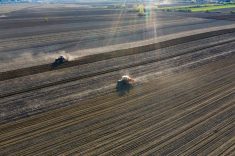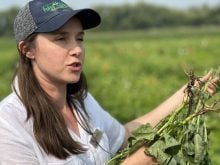When it comes to fertility planning for pulse crops, western Canadian farmers might want to consider soil testing this spring. That’s because there’ll likely be higher amounts of residual nitrogen left over and greater variability in nutrient levels due to last year’s drought, which curtailed crop uptake and nutrient utilization in many fields.
“It’s important, I would say this year more than ever, to do that soil sampling and testing and development of crop nutrition plans to check for what’s there and to adjust the rate accordingly for sufficiency,” says Jeff Schoenau.
Read Also

Claas brings 1000 Series SP forage harvesters to Canada
In mid-August, Claas unveiled its new line of Jaguar forage harvesters at an event in Visalia, California, deep in the heart of that state’s dairy region.
Schoenau, who presented the session “Fertility Decisions for Pulses After a Dry Year” at a pulse agronomy workshop hosted by Saskatchewan Pulse Growers last November, is a soil fertility professor at the University of Saskatchewan. He’s also the Saskatchewan Ministry of Agriculture soil nutrient management chair in the College of Agriculture and Bioresources.
While many farmers prefer to do their soil sampling in the fall, since it gives them more time to make fertility plans, Schoenau believes it’s generally a good idea to check a few fields for nutrients in the spring, just to gauge what’s actually there.
“If it’s a dry winter without much snow, it’s probably not going to change that much. But if, for example, it turns really wet, with lots of snow and runoff and a wet spring, I think it would be prudent to check again the residual available nutrient status in the soil in the spring because much of the residual N left in the soil in fall is in the form of nitrate, which is susceptible to loss under wet conditions,” he says.
“If you were going to zero in on changes, nitrogen would be the one to look at,” Schoenau adds. “Nitrate moves around so it can be redistributed readily in the soil profile. It can also be moved entirely out of the root zone, in some cases by leaching and by being lost in the gaseous form through the process of denitrification.
“Especially this year, I think it’s really important to get a handle on what’s there. Generally, we expect the levels to be high given the drought and lack of crop removal, but it’s variable and it may change from the fall to the spring.”
Good nutrient scavengers
Schoenau says while phosphorus and potassium levels generally won’t change much from fall to spring, sulphur could change a fair bit. “That’s because sulphate is mobile and moves around a lot with water in the soil profile and landscape and can be quite variable, not only spatially but also over time as well.”
While legumes do have high phosphorus requirements, they’re good at scavenging the soil for nutrients.
“Legumes can often mobilize and access phosphorus in the soil better than a lot of other crops can,” he says. “I think they should be able to do a pretty good job of utilizing residual unused phosphorus and also potassium, sulphur, even micronutrients, that are left behind in the fertilizer bands from 2021.
“Because they’re generally good nutrient scavengers, oftentimes we find that pulses aren’t as responsive to, for example, phosphorus fertilization as a lot of other crops are.”
Schoenau says low nutrient utilization by crops in very dry conditions can mean a considerable amount of fertilizer is left behind at the end of the season in the seed rows and fertilizer bands.
“That creates a lot of what we call microscale variability,” he says. “But, also, we can expect to see some larger variations over several metres and across fields.”
One reason for that is there’s typically more crop growth and associated nutrient uptake in lower parts of a field than in upland areas during a drought year like 2021. Schoenau says you could also see more second growth canola, volunteer cereals and pulses popping up in fields, “and that can also impact the nutrient availability and certainly be a source of variability across that field as well.”
It’s because of all this variability that Schoenau advises farmers and agronomists to consider a zone-type or directed sampling approach rather than random sampling if they decide to soil test their pulse fields this spring. He acknowledges that usually means extracting more core samples from a field, but it should provide a more accurate picture of where and how much nutrients are available to crops.
One strategy Schoenau recommends is to take a strip of soil and sample across the seedbed area such that both the residual fertilizer bands and the soil in between them are combined in the proportions they exist to create a composite sample that more accurately reflects what’s in the seedbed.
“That sampling generally involves more work and effort put into it, but I think it needs to be done to avoid bias or skew,” he says.
The effect on nitrogen fixation
Schoenau says it’s important to understand how high levels of soil available nitrogen affect nitrogen fixation in pulses, the process where rhizobia fix nitrogen from the air and supply it to pulse plants through the roots.
“What happens when you grow a pulse on a soil with high available nitrogen is that the contribution from biological nitrogen fixation will be reduced,” he says. “Generally, the plant will do fine, but it will use the inorganic nitrogen from the soil as a nitrogen source rather than sending the food to the rhizobia to get that nitrogen for free from the air.”
Schoenau says a general rule of thumb is if the combination of soil available nitrogen and applied nitrogen fertilizer gets above around 50 pounds per acre in the soil, then there’ll likely be a significant reduction in the proportion of nitrogen the plant receives from nitrogen fixation.
Because of this, Schoenau suggests it’s a good idea to grow something else rather than a pulse crop in those fields with really high levels of soil available nitrogen, since there’s less need for costly fertilizer and it will save farmers money.
Planting pulses where there’s lower levels of soil available nitrogen will also increase fertilizer-use efficiency, since the plants in those fields are more likely to rely on nitrogen fixation for nutrient needs.
“With what we might be expecting to pay for fertilizer in the upcoming growing season, I think soil nutrient availability assessment is more important than ever,” Schoenau says.
Plant stress caused by things like disease or too much or too little water can have a negative effect on biological nitrogen fixation and also the ability of the roots to access other nutrients. Schoenau says if root development is stressed by adverse conditions into 2022, it’s possible adding some phosphorus fertilizer or starter nitrogen to a pulse crop could be beneficial.
If 2022 turns out to be a growing season with lots of moisture, farmers could see some issues with additional disease and lodging in their pulse crops, since higher levels of soil available nitrogen can promote early vegetative growth and produce more plant biomass and a heavier canopy, Schoenau notes.
“That can be an issue associated with having a lot of available nitrogen in the soil,” he says. “But, generally, I don’t think that’s going to be a big factor unless you’ve got very high levels of available nitrogen and wet conditions.”
















